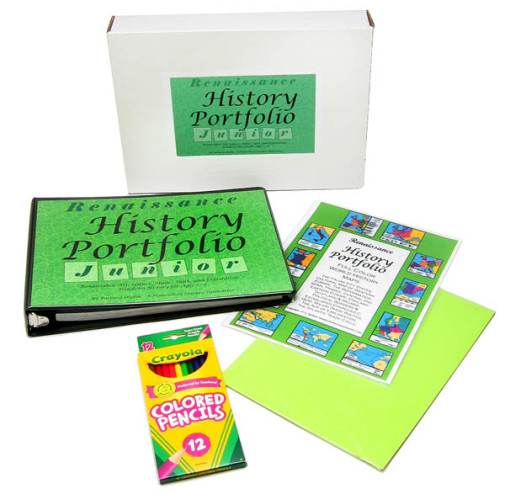We use cookies to make your experience better. To comply with the new e-Privacy directive, we need to ask for your consent to set the cookies. Learn more.
Renaissance History Portfolio Junior Kit
The Renaissance History Portfolio Junior is a junior version of the Renaissance History Portfolio "classic", and is perfect for children ages 5 - 9. The Junior Portfolio contains fewer notebooking pages than the "classic" version, and therefore requires much less writing. Notebooking activities focus on observation, comprehension, penmanship, copywork, memory work, beginning writing skills, and plenty of games and puzzles for reinforcement and review.
The Junior Portfolio is divided into two sections, with the first section containing notebooking pages printed on cardstock paper, and the second section containing the parent guide with all of the instructions and multi-level cut-and-paste activities necessary to complete the book.
There are so many unit studies and curriculums that culminate in the creation of a dedicated notebook which contains all of the work and information the child has learned about the topic. If you are looking for something better adapted to this process than the ol' binder and notebook paper combo, you will definitely want to check these out. Based on the same concept as a blank timeline, this series offers you actual history portfolios which hold many blank maps, spaces, and lined paragraphs for you to fill out for each time period. The books are divided chronologically over that time range, for example, the medieval book provides separate sections for the Christians, the West Roman Empire, the Celtic Tribes, the Germanic Tribes, the Building of Kingdoms (Frankish, England, France, and Germany), the East Roman Empire/Byzantium, and the World. Each section contains blank maps and empty spaces for copywork, drawings, reports, narrations, lists and more. A detailed table of contents at the beginning shows you what features are included for each time period, making it easier to plan with your history program (you may want to note that the appendix material and resource suggestions previously found in the History Portfolios are now found in the Teacher Guides for each time period). The end of the book provides a unique timeline, which is intended to be taken out of the book, attached sheet-to-sheet, and used to record events and important people that are studied. This series provides a worthy foundation for personalized, thorough history portfolios.
If you've been a little overwhelmed with the blank spaces in the History Portfolios - or just want some idea of what to include, these guides provide the answer. Each spiral-bound Teacher's Guide provides detailed suggestions for each and every image and text box in its corresponding Portfolio. Appendix and resource material (previously found in the Classic Portfolios) is now also included in the Teacher's Guides. Even though the Portfolios provide general suggestions, these Teacher's Guides eliminate the need to preplan every page. The material can be used "as is" by coloring, cutting, and pasting or it can become a springboard and source of ideas. All images are original - rendered from photographs and artifacts - and can be reproduced for family use. With the use of these Teacher's Guides, the History Portfolios can function as the framework for a complete course of study. Please note that Teacher's Guides are only needed for these "Classic" portfolios; if you are using a Junior History Portfolio for the younger set, you will not need a separate Teacher's Guide.
While the "Classic" History Portfolios are intended for 3rd grade and up, Junior Portfolios offer even younger children the opportunity to complete their own portfolios, too. Designed as a gentle introduction to both history and notebooking and very similar to the original History Portfolios, these contain more age-appropriate writing spaces as well as suggested material for three ability levels. A Parent Guide and Materials are included right in the book (back portion), but can be removed to allow the student to "own" his portfolio. History selections are coordinated with the Story of the World, but could be used with other history materials. Both Junior and "classic" History Portfolios are now bound in 3-ring binders for extra flexibility.
Full-color reference map sets are also available to help students complete the mapping activities in their portfolios. Created because maps for a certain time period or civilization may be difficult to find, these maps directly correlate with the black-and-white maps in the portfolios, and make the mapping activities much easier. While we sell the pieces separately, the History Portfolio's creator has also made some kits available, which contain everything you could want for a full-fledged history notebooking experience. Classic kits are currently available for Ancient, Medieval and Renaissance periods and Junior kits are available for Ancient and Medieval periods. Kits include portfolio, map set, colored pencils, and ten sheets of 65 lb. multicolored card stock paper. Classic Sets also include the Teacher's Guide. - Melissa/Janice
Kits include portfolio, map set, colored pencils, and ten sheets of 65 lb. multicolored card stock paper.
| Product Format: | Other |
|---|---|
| Brand: | History Portfolio |
| Author: | Barbara Shukin |
| Grades: | K-3 |
| ISBN: | 9780982500610 |
| Length in Inches: | 10.25 |
| Width in Inches: | 13.75 |
| Height in Inches: | 2 |
| Weight in Pounds: | 3.35 |

